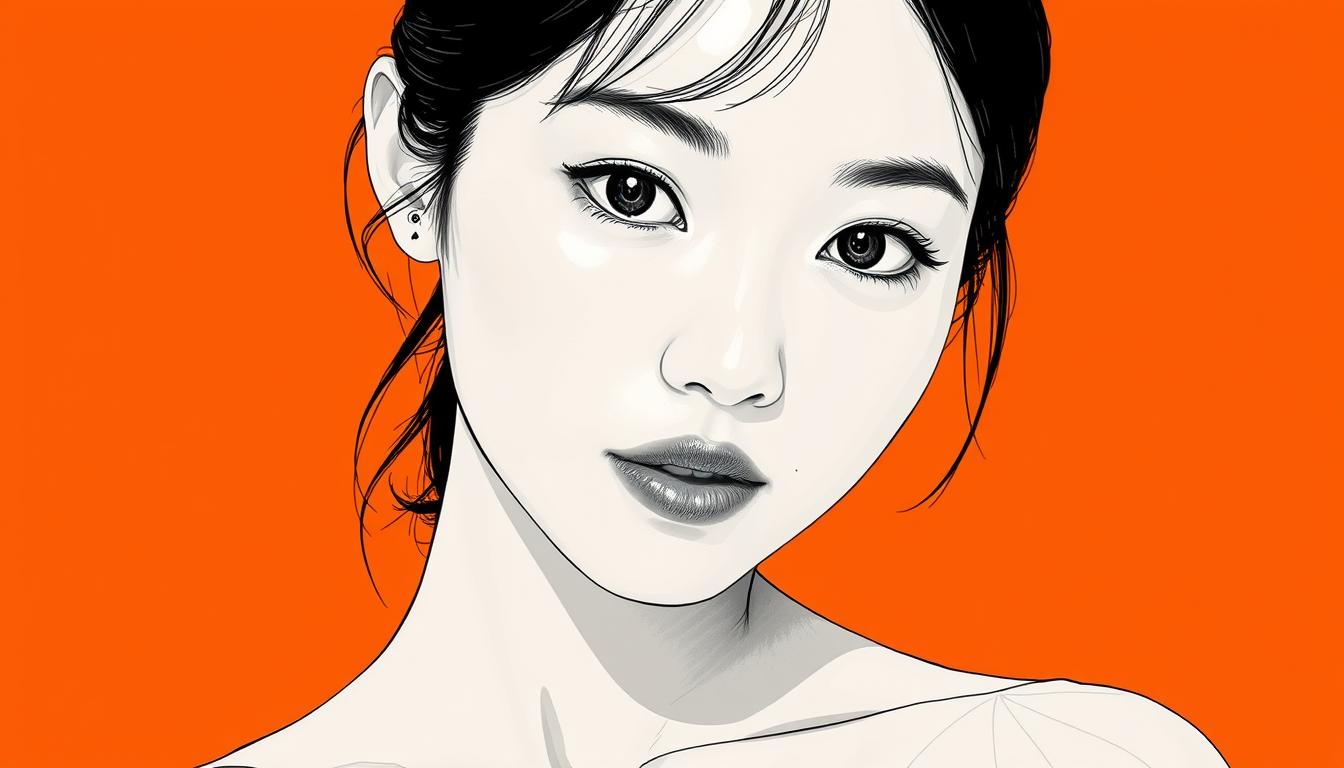A single photograph can change a life. For Kanna Hashimoto, that moment arrived in 2013. A fan’s picture of the young performer went viral, capturing nationwide attention almost overnight.
Born on February 3, 1999, in Fukuoka Prefecture, her path began much earlier. She signed with a local agency as a child. Her family, including an older brother and a twin brother, grounded her life away from the spotlight.
The viral fame launched her from local idol to national film star. She transitioned deliberately from music to acting, leaving her idol group behind. Her career arc shows a clear focus on serious roles in film and television.
Media labels often called her “cute and angelic.” Yet she has consistently worked to show greater depth and range. Kanna Hashimoto commands major roles today, a respected figure in Japan’s entertainment industry.
Early Life and Career Beginnings
Long before a viral photo, a young girl in Fukuoka was already building her future. Her roots provided a steady launchpad for the career to come.
Childhood in Fukuoka Prefecture
Kanna Hashimoto grew up in a family of five. Her parents, older brother, and twin brother created a grounded home life.
This environment fostered early ambition. At just eight years old, she signed with the local agency Active Hakata.
Her first work appeared in commercials for local news and businesses around Fukuoka. In 2009, she joined DVL, a co-ed dance and vocal unit.
These were her initial steps into performance. Artistic influence ran in the family. Her aunt, Ryōko Morooka, is a respected organist.
Even at that time, her goal was clear. She wrote “actress” as her dream job in her elementary school yearbook. Fukuoka was both her home and her first stage.
First Steps in the Entertainment Industry
In 2009, a new member joined a Fukuoka-based performance group, starting a dual-track career. She became part of DVL, a co-ed dance and vocal unit. This was her first professional environment.
Two years later, the group evolved. She transitioned into its all-female successor, Rev. from DVL. She spent six formative years there as a dedicated member and singer.
Her acting career began separately, through merit. She auditioned for director Hirokazu Kore-eda’s film I Wish. She earned the role of Kanna Hayami for her 2011 debut.
Simultaneously, she honed her craft locally. She performed in children’s theater productions run by her agency. She also appeared in dramas for a regional TV station.
These early projects were a crucial training ground. She learned the fundamentals of dancing, singing, and handling cameras. This period built the skills for her future breakthrough.
| Year | Project | Role / Contribution | Significance |
|---|---|---|---|
| 2009 | DVL | Member, Performer | First professional group, foundational training |
| 2011 | Rev. from DVL | Member, Singer | Six-year tenure in successor group |
| 2011 | Film: I Wish | Kanna Hayami | Major film debut by acclaimed director |
| 2011 | Local Theater & TV | Actor | Skill development outside national spotlight |
Breakthrough Moment: The Viral Photo Phenomenon
The internet erupted in November 2013 over a single image captured during a weekend performance. A blogger named Hakata no Take photographed the actress at a Rev. from DVL outdoor concert. This moment would define her career trajectory.
Social Media Impact and Public Reaction
The photo spread rapidly across 2channel and Twitter. It gained labels like “beyond angelic idol” and “once in a millennium talent.” Public reaction reached unprecedented levels.
A Naver Summary post about the phenomenon exceeded 550,000 views within days. The agency’s website server crashed from excessive traffic. National news programs featured the trend, showing search spikes that reached Chinese users.
| Media Outlet | Program/Platform | Coverage Type | Timeline |
|---|---|---|---|
| NHK | Late-night news | Trend feature with search data | November 2013 |
| Asahi TV | Good! Morning | Mention and discussion | November 2013 |
| Fuji TV | Mezamashi TV | Photo feature segment | November 2013 |
| Naver Summary | Online article | 550,000+ views | By November 7 |
Industry Opportunities Triggered by the Photo
The viral moment brought immediate professional offers. Commercial appearances and interview requests flooded her agency. More significantly, it caught a major studio executive’s attention.
Kadokawa’s Shinichiro Inoue saw the photo and contacted the agency directly. He expressed immediate interest in casting her for a film role. This led to her starring part in Sailor Suit and Machine Gun: Graduation.
Kanna Hashimoto later reflected on the irony. She noted the photo captured her frustration rather than manufactured perfection. This authenticity may have contributed to its powerful impact.
The Rise of Kanna Hashimoto in Film and Television
The viral attention demanded a professional response. Offers arrived quickly, testing the young performer’s ability to transition from online sensation to working actress.
This period marked a time of rapid growth. She built a foundation through varied projects.
Initial Film Debuts and Early Roles
In April 2014, she joined the variety show Teen!Teen! as a regular. She also became the youngest MC in the history of the online karaoke “DAM Channel.”
Her first nationally broadcast drama role came that July. She appeared in an episode of Water Polo Yankees. This was a significant step onto a larger stage.
Her first major film role post-viral fame arrived in 2015. She played Ritsu, an AI weapon, in the live-action Assassination Classroom.
Producer Juichi Uehara explained the casting. He cited her “miraculous presence that combines perfection and cuteness.” This quality suited roles blending human and otherworldly traits.
These early films and television spots were crucial building blocks. They allowed her to prove her craft beyond the initial hype.
Transitioning from Idol Singing to a Serious Acting Career
The year 2017 marked a deliberate pivot, a closing of one chapter to fully embrace another. After years of balancing two demanding paths, the actress chose to focus solely on her craft.
Rev. from DVL and the Shift in Focus
Hashimoto was a dedicated member of the Fukuoka-based idol group Rev. from DVL for six years. During this time, the group released several singles, including “LOVE-arigatou-” and “Kimi ga Ite Boku ga Ita.”
Their final album, “NEVER SAY GOODBYE -arigatou-,” arrived in 2017. This release coincided with her decision to leave the music scene behind. She graduated from the group on March 31st with a final live performance in her hometown.
This exit was part of a larger symbolic change. She also graduated high school and left television programs like “Teen!Teen!” that same month. She stated her hope to become someone who could give courage to others through careful work.
In April 2017, she announced plans to move to Tokyo. This geographic shift mirrored her professional commitment. She traded the security of the group for the challenge of a full-scale acting career.
Iconic Film Roles and Blockbuster Performances
A string of blockbuster films cemented her status as a leading actress. These roles demanded more than a cute image. They required physical change, comedic skill, and dramatic weight.
Her first major starring role arrived in 2016. She played a high school yakuza boss in Sailor Suit and Machine Gun: Graduation. She also performed the theme song, which topped music charts.
Sailor Suit and Machine Gun: Graduation
This film proved her box-office power. She fully committed to the role of Izumi Hoshi.
Gintama, Kaguya-sama: Love Is War and Beyond
In 2017, she transformed for Gintama. She dyed her hair orange to play the alien fighter Kagura. The film was the year’s top-grossing live-action hit.
She returned for the sequel, Gintama 2: Rules Are Made To Be Broken. Her performance was praised for its energy and accuracy.
She then took on the clever Kaguya Shinomiya in Kaguya-sama: Love Is War. The film debuted at number one. She reprised the part in the finale, Kaguya-sama Final: Love Is War.
Her commitment to franchises is clear. She played the warrior He Liao Diao across four Kingdom films from 2019 to 2024.
| Film | Year | Role | Notable Achievement |
|---|---|---|---|
| Gintama | 2017 | Kagura | #1 Japanese live-action film of the year |
| Kaguya-sama: Love Is War | 2019 | Kaguya Shinomiya | #1 weekend audience mobilization |
| Kingdom | 2019-2024 | He Liao Diao | Four-film series commitment |
| The Disastrous Life of Saiki K. | 2017 | Kokomi Teruhashi | Played a parody of a “perfect” idol |
Other roles, like in From Today, It’s My Turn!!, showed her range. Each part built a reputation for serious, dedicated work.
Diverse Television Appearances and Guest Roles
While her film career soared, television offered a steady rhythm of diverse roles. This work kept the actor visible to audiences between major film releases.
Her first serial drama heroine role arrived in 2017. She played Keiko Usuki in Metropolitan Police Department Ikimono Section. This part showcased her as an animal-loving police officer.
She also demonstrated comedic skill on variety shows. In 2018, she joined the popular “Gochi!” segment of Guru Guru Ninety-Nine for a year.
Her dramatic range expanded across networks and genres. She starred in the 2019 romance One Page Love as Akari Minase. In 2021, she took on the mystery series Nemesis, later reprising her role for a film.
Recent projects highlight her continued prominence. In 2024, she starred in the historical drama Banpaku no Taiyo. She also began the prestigious 2024-2025 morning drama Omusubi.
This casting news signals major recognition in Japanese television. Her upcoming role in the 2025 series Ameku Takao no Suiri Karte confirms her lasting small-screen appeal.
Stage and Musical Performances: Live Adaptations
Live theater presented a formidable test for the established screen actress. The medium demands sustained performance without editing safety nets.
Spirited Away: Live on Stage
In February 2020, news broke of her theatrical debut. She would star in the stage adaptation of Hayao Miyazaki’s beloved film Spirited Away.
British director John Caird helmed the ambitious production. The role of Chihiro featured double casting with Mone Kamishiraishi.
Both actresses alternated performances, bringing unique interpretations to the heroine. This approach enriched the character’s depth.
The production finally premiered in February 2022 after pandemic delays. Translating Studio Ghibli’s fantasy world to live theater required immense technical creativity.
| Aspect | Details | Significance |
|---|---|---|
| Director | John Caird | Acclaimed British theater director |
| Premiere Date | February 2022 | After two-year pandemic delay |
| Casting Approach | Double casting | Hashimoto and Kamishiraishi alternated as Chihiro |
| Critical Reception | 97% Rotten Tomatoes | Exceptional rating for filmed version |
The filmed version earned a remarkable 97% rating on Rotten Tomatoes. This success demonstrated the production’s artistic achievement.
This stage work expanded her performance toolkit significantly. She mastered vocal projection and physical theater techniques absent from screen acting.
The Spirited Away adaptation marked a deliberate career expansion. It showed her commitment to mastering diverse performance mediums.
Accolades, Awards, and Industry Recognition
Recognition for her craft arrived in 2017, marking a pivotal moment in her professional journey. This formal validation from industry peers signaled a successful transition from viral sensation to respected artist.
The awards and honors that followed reflect both her artistic merit and her broad popular appeal.
Elan d’or Award and Japan Academy New Actor Award
In March 2017, Kanna Hashimoto won the Japan Academy New Actor Award for Sailor Suit and Machine Gun: Graduation. She accepted the honor with humility.
“With this award an encouragement,” she stated, “I will continue to devote myself to the world of film and the path of acting with sincerity.”
Three years later, she received the 2020 Elan d’or Award for Newcomer of the Year. The ceremony held a special significance.
Director Hirokazu Kore-eda, who gave her a debut role in I Wish, presented the award. It was a poignant full-circle moment.
Critical Acclaim and Public Honors
Public polls have consistently celebrated her presence. A 2015 web poll named her the “Cutest Idol” by popular vote.
The industry also entrusted her with significant roles. She served as an ambassador for the 30th Tokyo International Film Festival.
Her mission was to convey the appeal of films to her own generation.
Even lighter achievements showcase her connection with audiences. In 2020, she set a Guinness World Record on a variety show.
She pulled 157 tissues from a box in one minute. This playful feat demonstrates a willingness to engage beyond serious drama.
Each accolade, from the prestigious to the popular, charts her path as a dedicated actress.
Endorsements, Commercials, and Brand Collaborations
Beyond the silver screen, another stage showcased her appeal: the commercial marketplace. Major brands recognized her marketability early in her career ascent.
Key Campaigns and Media Partnerships
The 2015 “Devilish Kanna” campaign for Rohto Pharmaceutical became legendary. Director Oki Miichi intentionally cast against her angelic image.
He believed someone known as “exceedingly angelic” playing a devil would create buzz. The strategy worked brilliantly, helping the Lip Baby Crayon product reach 200% of its sales target.
She partnered with diverse corporations including NTT Docomo, UHA Mikakuto, and Nissin Foods. Each collaboration demonstrated her cross-sector appeal.
Enhancing Her Public Profile
Commercial work provided financial stability between major acting projects. It also kept her face visible to audiences nationwide.
In 2020 Kantō region news, she ranked first in companies represented. She appeared in more commercial broadcasts than any other talent during 2021’s first three days.
This commercial presence balanced her artistic film career. Endorsements became another dimension of professional success in Japanese entertainment.
The Public Image: From Cute to Compelling
Public perception is a powerful force, often built on a single moment. For this performer, a viral photo in 2013 instantly framed her as “cute and angelic.” This label became her professional entry point.
Industry leaders leaned into this image. A producer cited her “miraculous presence that combines perfection and cuteness” for a key film role. A director used her “exceedingly angelic” reputation to create a clever, contrasting commercial campaign.
Yet the actress herself felt a disconnect from the famous photo. She saw frustration in her own expression, not the perceived perfection. This gap between public image and self-perception fueled a desire for more complex work.
Her career choices became a deliberate response. She took on roles as a yakuza boss and an alien fighter. These parts required physicality and grit, moving far beyond a pretty facade.
Directors recognized her range, casting her repeatedly in demanding, unglamorous parts. She navigated the tricky transition from idol to serious actress with clear intent. Her filmography now tells a story of depth, challenging that initial, simplistic label.
Personal Life and Roots in Fukuoka
While Tokyo became her professional home, Fukuoka remains the emotional touchstone of her identity. The actress maintains strong ties to her birthplace despite her career relocation.
She was born february 3, 1999, in Fukuoka Prefecture. Her family provided a stable foundation away from the entertainment industry spotlight.
| Year | Event | Location | Significance |
|---|---|---|---|
| 1999 | Birth | Fukuoka Prefecture | Family roots established |
| March 2017 | High School Graduation | Fukuoka | Educational milestone |
| June 2017 | Tokyo Residency Announcement | Tokyo | Professional relocation |
| December 2017 | One-Day Police Chief | Fukuoka | Hometown connection maintained |
Her family includes parents, an older brother seven years her senior, and a twin brother. Artistic influence runs in the family through her aunt Ryōko Morooka, an accomplished organist.
In 2017, she publicly confirmed her move to Tokyo and participation in local elections. That same year, she returned to Fukuoka as honorary police chief for holiday safety campaigns.
Kanna Hashimoto balances public visibility with private boundaries. She shares selective details about family and civic engagement while protecting personal relationships from media scrutiny.
Recent Career Milestones and Evolving Projects
The years 2022 to 2025 reveal a consistent pattern of ambitious role selection. Kanna Hashimoto maintains a demanding schedule across film and television.
Latest Film and Television Ventures
Her 2022 film slate showcased remarkable range. She played an action heroine in The Violence Action, a central character in the mystery Re/Member, and a key role in the fantasy Black Night Parade.
This momentum continued through 2023 with three distinct projects. She appeared in the period drama One Last Bloom, the psychological thriller The Forbidden Play, and the fantasy comedy Once Upon A Crime.
Her commitment to the Kingdom franchise remained strong. She returned for the third installment in 2023 and the fourth film in 2024, demonstrating loyalty to successful ensemble work.
Television offered equally prestigious opportunities. She starred in Banpaku no Taiyo (2024), a major anniversary drama for TV Asahi. The production featured a theme song by pop icon Ayumi Hamasaki.
Her casting in the 2024-2025 morning drama Omusubi represents a career pinnacle. This slot reaches millions of viewers daily. Future news includes the 2025 mystery series Ameku Takao no Suiri Karte.
This sustained output shows an artist carefully building a legacy. Each project challenges different skills and reaches unique audience segments.
Influence on Japanese Cinema and Pop Culture
Cultural influence often arrives through unexpected channels, reshaping industry norms along the way. The actress’s journey from viral fame to respected performer changed how Japan views digital popularity.
Her career demonstrated that internet fame could launch serious artistic work. Industry attitudes shifted as her success proved social media’s potential.
Cultural Impact and Future Prospects
The actor became a key figure in live-action manga adaptations. Films like Gintama and Kaguya-sama showed her commercial power.
Twitter Japan ranked her eighth among trending actors worldwide in 2019. This recognition highlighted her international reach.
Her consistent presence across media created cultural omnipresence. Film, television, commercials, and stage work kept her visible.
The 2019 launch of her official fan club marked major status. Fan meetings in Osaka and Tokyo confirmed organized support.
Kantō region data showed her leading commercial appearances in 2020. This commercial dominance complemented her artistic achievements.
She represents both product and shaper of contemporary entertainment. Her career reflects current industry trends while influencing them.
Challenges and Growth: Navigating Fame in the Digital Age
Digital fame arrived without warning, creating challenges that would define her career path. At fourteen, a viral photo brought nationwide attention overnight. The label “once in a millennium talent” created impossible expectations.
Balancing two careers demanded immense energy. She maintained commitments with Rev. from DVL while pursuing acting roles. This dual-track approach required careful time management and focus.
Practical challenges emerged beyond the studio. In 2018, her scheduled university appearance was cancelled. Overwhelming crowds created safety concerns that police could not guarantee.
The 2017 move from Fukuoka to Tokyo represented personal upheaval. She left family and hometown support systems behind. Kanna Hashimoto also expressed disconnect with her viral image’s appeal.
| Challenge | Timeline | Response | Outcome |
|---|---|---|---|
| Sudden Viral Fame | 2013 | Professional transition | Managed expectations through serious roles |
| Dual Career Balance | 2013-2017 | Graduated from Rev. from DVL | Focused solely on acting career |
| Public Safety Concerns | 2018 | Cancelled appearances when necessary | Prioritized safety over visibility |
| Geographic Relocation | 2017 | Moved to Tokyo for career | Established professional independence |
These experiences shaped her approach to fame. Each challenge required adaptation and personal growth. The actress developed resilience through navigating digital age pressures.
Final Reflections on a Blossoming Career
From Fukuoka stages to Tokyo film sets, a career built on careful choices continues to unfold with purpose. Nearly two decades of work reveal a clear pattern. Each transition was deliberate, from leaving Rev. from DVL to focusing solely on acting.
Her filmography now spans over forty films across diverse genres. She commands major franchises while taking risks in smaller projects. Roles in action films like The Violence Action showcase physical commitment. Comedic timing shines in Love Is War, while dramatic depth anchors serious works.
The actress remains guided by her 2017 statement about giving courage through careful work. With projects extending into 2025, her career shows no signs of narrowing. She continues to connect each role to the next, building a legacy of range and reliability.




